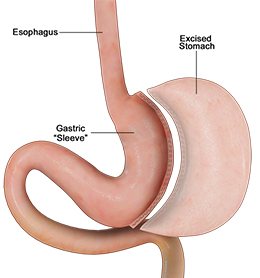
Introduction
Sleeve gastrectomy, also referred to as vertical sleeve, gastric sleeve, or tube gastrectomy, is a surgical procedure performed for the treatment of obesity. The procedure is a restrictive bariatric surgery to treat extremely obese patients with a high BMI of 40 and above. It encourages weight loss by restricting the stomach size so it holds only a limited amount of food. This helps patients to eat less without hampering the normal digestive process.
Sometimes sleeve gastrectomy is carried out as a first stage of a 2-stage operation in extremely obese patients with a BMI of 60 or more. This is done to achieve a considerable amount of weight loss so it is safer for the patient to undergo a second bariatric surgery if needed.
Disease Overview
Obesity is a chronic condition in which there is an excessive accumulation of fat in the body.
Obesity is defined as a Body Mass Index (BMI) of 30 to 34.9 and extreme or morbid obesity is a BMI of 40 or more.
Obesity is a global problem affecting people of almost all age groups and is associated with increased risk of cardiac problems, diabetes, high blood pressure, breathing difficulties, and other diseases.
Indications:
Sleeve gastrectomy is indicated for people with a BMI of 40 and more, and also in those whose BMI is 35 to 40 and suffering from obesity-associated conditions.
The surgery is recommended when diet, exercise, or medication have not helped in reducing the patient's weight.
Surgery:
The procedure is performed under general anesthesia. The surgeon makes 2 to 5 small incisions on your abdomen. A laparoscope, a thin instrument with a light and camera attached, is inserted through one incision, allowing your surgeon to clearly view the internal organs on a monitor.
Additional surgical instruments are inserted through the other incisions. Your surgeon will remove nearly 75-80% of the stomach. A thin sleeve shaped like a banana is created by stapling the remaining part of the stomach. At the end of the procedure, the incisions are closed with sutures. The entire procedure takes about 60 to 90 minutes to complete.
Advantages and Disadvantages of sleeve gastrectomy:
Advantages:
- Reduced stomach size makes you feel full sooner.
- Normal functions of the stomach are retained.
- Simpler than other bariatric surgeries.
- Can be performed laparoscopically
- Shorter hospitalization stay
- Less operative time
- No implant used as in lap band surgery.
- Minimal post-operative pain and discomfort.
- Shorter recovery time
Disadvantages:
- Irreversible
- Need for second surgery in highly obese patients
- Exposure to surgical risks twice in the case of 2-stage procedures
Post-operative care:
- Your doctor will prescribe pain-relieving medications to keep you comfortable following the procedure.
- You will be advised to take medication to reduce the amount of acid produced by your stomach.
- Avoid strenuous exercises and lifting heavy weights until approved by your surgeon
- For the first month after the procedure, eat only small amounts of soft foods
- Sip water throughout the day to prevent dehydration.
- Eat a highly nutritious diet rich in proteins with a low-fat content.
- Your dietitian will tailor a new diet regimen for you to follow.
Risks and Complications:
As with any surgery, there are potential risks and complications involved. The risks include blood loss, infections, problems associated with anesthesia, and deep vein thrombosis
(blood clot in the leg).
The major complication following sleeve gastrectomy surgery is occasional leakage or breakdown of the gastric contents from the staple line that secures the divided stomach.
Summary:
Sleeve gastrectomy surgery is a common weight loss procedure to treat obesity, one of the leading causes of preventable death worldwide. The surgery results in a smaller, tube-like stomach pouch that quickly fills after small amounts of food are eaten enabling patients to drop weight quickly without feeling hungry.














